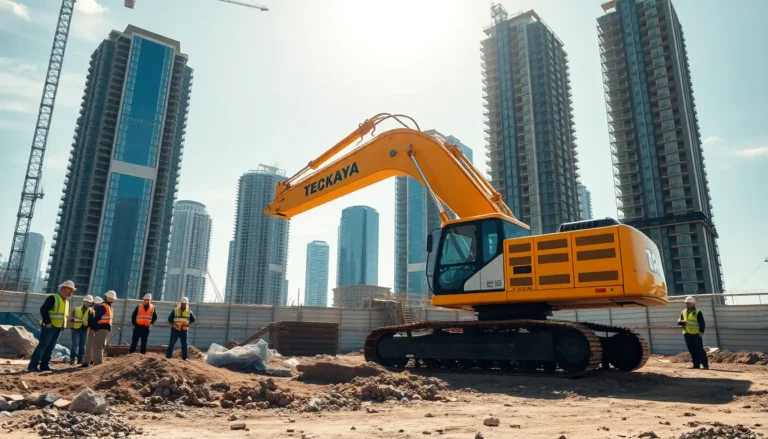Table of Contents
ToggleIn today’s fast-paced digital world, keeping a laptop up to date is essential for optimal performance. As software demands increase, many users find their once-speedy machines lagging behind. Laptop upgrades can breathe new life into a device, enhancing speed and functionality without the need for a complete replacement.
Whether it’s upgrading RAM for better multitasking or swapping out an old hard drive for a speedy SSD, these enhancements can significantly improve user experience. Understanding the benefits and options available empowers users to make informed decisions, ensuring their laptops remain efficient and capable of meeting their evolving needs.
Importance of Laptop Upgrades
Upgrading laptops enhances performance and longevity, addressing software demands that can slow devices. Increased RAM boosts multitasking capabilities, allowing users to run multiple applications simultaneously without lag. Replacing traditional hard drives with solid-state drives (SSDs) results in faster boot times and quicker file access.
Upgrading components not only improves speed but also provides better overall functionality. For example, newer graphics cards enhance visual output for gaming and design tasks, increasing productivity. Enhanced cooling solutions prevent overheating, which prolongs device life.
Understanding the types of available upgrades informs decision-making. For instance, storage upgrades offer more space for files, while improved CPUs handle complex applications effectively. Recognizing the need for these upgrades ensures laptops meet evolving requirements.
Common Types of Laptop Upgrades

Upgrading a laptop typically involves several components that enhance performance and functionality. Understanding these common types helps users make informed choices.
RAM Upgrades
RAM upgrades increase a laptop’s memory capacity, allowing for improved multitasking and overall system responsiveness. Laptops often come with 4GB or 8GB of RAM, but upgrading to 16GB or higher can significantly enhance performance for demanding applications and tasks. When replacing or adding RAM, users should ensure compatibility with their laptop’s motherboard specifications and consider the RAM type (e.g., DDR4) and speed (measured in MHz).
Storage Upgrades
Storage upgrades involve replacing traditional hard disk drives (HDDs) with solid-state drives (SSDs). SSDs provide faster data access speeds, reducing boot times and improving file loading times. Users can also opt for additional storage by installing a larger SSD or a combination of SSD for the operating system and HDD for supplementary data. When upgrading, checking the physical size (e.g., 2.5-inch, M.2) and interface (e.g., SATA, NVMe) ensures successful installation.
Graphics Card Upgrades
Graphics card upgrades enhance a laptop’s visual output, essential for gaming, video editing, and design work. Integrated graphics often limit performance, so upgrading to a dedicated graphics card can vastly improve frame rates and rendering quality. However, not all laptops support graphics card upgrades, particularly ultrabooks and thin models. Users should verify compatibility and consider external GPU (eGPU) solutions if the internal upgrade isn’t feasible.
How to Determine What to Upgrade
Determining which laptop upgrades are necessary involves evaluating existing components and identifying specific user needs. This assessment ensures a tailored approach to enhancing performance.
Assessing Your Current Hardware
Assessing current hardware involves a thorough examination of several key components.
- RAM: Check the amount of RAM currently installed. Upgrading from 8GB to 16GB or higher significantly boosts multitasking capabilities.
- Storage: Examine the storage type and capacity. Replacing a traditional hard drive with an SSD offers noticeable speed improvements.
- Processor: Review the CPU specifications. An older processor may limit performance, especially for demanding applications.
- Graphics Card: Investigate the GPU details. If gaming or graphic design is a priority, an upgrade may enhance visual performance.
- Cooling System: Assess the laptop’s cooling system. An upgraded cooling solution can improve performance during resource-intensive tasks.
Gathering this information provides a solid foundation for deciding what upgrades to pursue.
Identifying Your Needs
Identifying specific needs helps in targeting the right upgrades.
- Usage Type: Determine how the laptop is used. Users focused on gaming, design, or video editing require more powerful components.
- Software Requirements: Evaluate the requirements of current software applications. Certain programs may demand higher specifications.
- Future-Proofing: Consider long-term plans and potential future needs. Upgrading components early can extend the laptop’s lifespan and relevance.
- Budget Considerations: Establish a budget for upgrades. Prioritize enhancements that provide the most impact without overspending.
- Compatibility Issues: Check compatibility of desired upgrades with existing hardware.
By clearly defining these needs, users optimize their upgrading strategies and effectively enhance their laptop’s performance.
Step-by-Step Guide to Upgrading
Upgrading a laptop requires careful preparation and execution to ensure success. Follow these detailed steps for an effective upgrade.
Preparing for the Upgrade
- Gather Tools: Ensure access to basic tools, including screwdrivers, an anti-static wrist strap, and a clean workspace.
- Check Compatibility: Verify the compatibility of the new components with the laptop model by consulting the manufacturer’s website or user manual.
- Backup Data: Create a backup of important files to prevent data loss during the upgrade process.
- Research: Identify the specific upgrades needed, such as RAM, SSD, or graphics card, based on previous evaluations of existing components and user needs.
Performing the Upgrade
- Power Down: Turn off the laptop completely, unplug it, and remove the battery if possible.
- Access Components: Open the laptop case carefully, ensuring not to damage any internal parts.
- Replace Upgrades:
- RAM Installation: Remove old RAM modules by releasing the clips, then insert new modules at an angle and press down until they click into place.
- SSD Replacement: Unscrew and slide the old hard drive out, then insert the new SSD into the same slot, securing it with screws.
- Graphics Card Upgrade: If applicable, remove the current graphics card, ensuring to disconnect any cables first, then install the new graphics card by aligning it with the slot and securing it.
- Reconnect and Close: Reconnect any cables, replace the laptop casing, and secure all screws to ensure everything is properly installed.
- Boot Up: Power on the laptop to check for proper installation and verify that the new components are recognized in the system settings.
- Install Drivers: Update drivers for new hardware components to ensure compatibility and optimal performance.
Potential Challenges and Solutions
Upgrading laptops can encounter several challenges, but solutions exist to tackle each issue effectively.
Compatibility Issues
Compatibility of new components poses a significant challenge during upgrades. Laptop models often have specific hardware requirements. Users must ensure that new RAM, SSDs, or graphics cards match these specifications.
Solution: Research the laptop model and list compatible components. Utilize manufacturer resources or trusted online forums to validate compatibility before purchasing.
Limited Upgrade Options
Certain laptops, especially ultrabooks, feature soldered or integrated components that limit upgrade possibilities. Users may find themselves restricted by the design architecture of their devices.
Solution: Investigate the specific model’s upgrade potential. Consider laptops known for easy upgrades if significant enhancements are needed.
Installation Difficulties
Installation may intimidate some users, especially those unfamiliar with computer hardware. Mistakes during installation can lead to component damage or system malfunctions.
Solution: Follow reliable online guides or video tutorials that demonstrate each step of the upgrade process. Practicing on similar non-essential devices can build confidence before addressing primary laptops.
Data Loss Risk
Data loss during upgrades presents another challenge, especially when replacing storage drives. Users may inadvertently erase information if proper backup procedures are not followed.
Solution: Back up important files using cloud services or external drives. Utilize imaging software to create a complete backup of the system before proceeding with major upgrades.
Cost Considerations
The expense of upgrades can deter users. High-quality components may strain budgets, particularly if multiple upgrades are necessary.
Solution: Prioritize upgrades based on needs and budget constraints. Focus on high-impact areas like RAM or SSDs that deliver substantial performance boosts without overspending.
Performance Expectations
Users may expect immediate and significant performance improvements post-upgrade, leading to potential disappointment if results do not meet these expectations.
Solution: Set realistic performance goals tied to specific upgrades. Understanding that some upgrades yield gradual improvements rather than instant results helps manage expectations effectively.
Upgrading a laptop can significantly enhance its performance and extend its lifespan. By focusing on key components like RAM, storage, and graphics cards, users can tailor their devices to meet specific needs. Evaluating current hardware and understanding personal requirements are crucial steps in this process.
With the right upgrades, laptops can handle modern software demands with ease. Following a systematic approach ensures a smooth upgrade experience while addressing potential challenges along the way. Ultimately, investing in upgrades not only improves functionality but also ensures that laptops remain relevant in an ever-evolving digital landscape.







